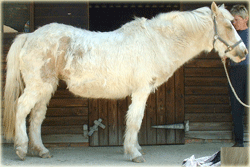Hyperadrenocorticism
Caused by the development of either a growth in the pituitary gland (pituitary adenoma) or enlargement of the gland (hyperplasia). The pituitary is a small, hormone producing, gland found at the base of the brain.
(Pars intermedia generally affected in horses rather than pars distalis in other species. Pars distalis is major source of ACTH(adrenocorticotrophic hormone), on which corticosteroids have a negative feed back effect. Pars intermedia in normal horses produces some ACTH but does not have a negative feed back.)
Symptoms:
- Generally in horses and ponies over 15 years of age (more commonly 20-25)
- Develop an abnormally dense, curly hairy coat. Often do not have normal seasonal shedding of their coat, seen most obviously in the summer.
- May lose weight and sometimes have abnormal distribution of fat around the body. (Sometimes have bulging supraorbital fat pads, and also seen on neck, back or tail head.)
- Polydypsia and polyuria (increased thirst and increased urination) may be seen.
- They often have increased susceptibility to parasite infestations and infections.
- The reproductive cycles of mares are often affected.
- Laminitis is the most common presenting complaint.
- They often have a marked insulin resistance.
- High blood glucose and glucose in the urine are common.
- High plasma cortisol levels found in about 50% of cases.
- Some have hyperlipdaemia. (increased “fat” products in the blood, seen in blood samples when plasma is creamy rather than yellow and clear.)
Diagnosis: Often just from the clinical signs – Laminitis in old, hairy animals.
There are a variety of blood tests that can be done, the more diagnostic ones being more complicated to do.
- Dexamethasone Suppression Test
- Plasma ACTH Concentration
- TRH (thyroid releasing hormone) Stimulation Test
- Insulin – not specific
- Cortisol – not useful
Treatment:
- Cyproheptadine (Periactin) – variable response reported .
- Pergolide mesylate (Parlodel, Celance) – generally better response but expense significant if higher doses required.
- Other medication and herbal treatments either have side effects or unproven.
In my opinion, laminitis occurs due to the effect of cortisol on glucose metabolism in the feet, as in Equine Metabolic Syndrome. I believe that these two conditions are best managed by providing a suitable diet for the age and condition of the horse, generally low in NSCs (See Fructans and Management of laminitis), and where possible to maintaining the horse in some form of exercise. This may not be possible due to the horse’s age or coping with chronic laminitis or for other reasons.
It may be beneficial to clip the horses.